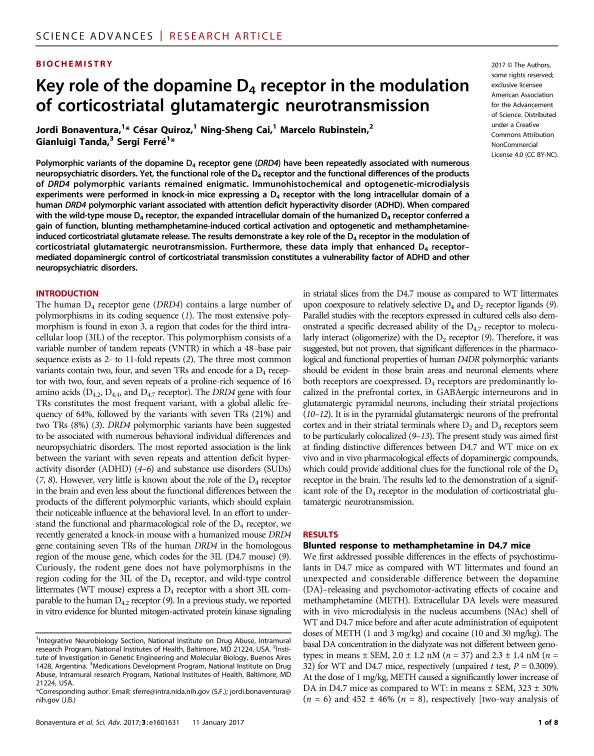Mostrar el registro sencillo del ítem
dc.contributor.author
Bonaventura, Jordi
dc.contributor.author
Quiroz, César
dc.contributor.author
Cai, Ning Sheng
dc.contributor.author
Rubinstein, Marcelo

dc.contributor.author
Tanda, Gianluigi
dc.contributor.author
Ferrer Gonzalez, César Sergio

dc.date.available
2018-04-03T21:31:11Z
dc.date.issued
2017-01
dc.identifier.citation
Bonaventura, Jordi; Quiroz, César; Cai, Ning Sheng; Rubinstein, Marcelo; Tanda, Gianluigi; et al.; Key role of the dopamine D 4 receptor in the modulation of corticostriatal glutamatergic neurotransmission; American Association for the Advancement of Science; Science Advances; 3; 1; 1-2017; 1-8; e1601631
dc.identifier.issn
2375-2548
dc.identifier.uri
http://hdl.handle.net/11336/40610
dc.description.abstract
Polymorphic variants of the dopamine D4 receptor gene (DRD4) have been repeatedly associated with numerous neuropsychiatric disorders. Yet, the functional role of the D4 receptor and the functional differences of the products of DRD4 polymorphic variants remained enigmatic. Immunohistochemical and optogenetic-microdialysis experiments were performed in knock-in mice expressing a D4 receptor with the long intracellular domain of a human DRD4 polymorphic variant associated with attention deficit hyperactivity disorder (ADHD). When compared with the wild-type mouse D4 receptor, the expanded intracellular domain of the humanized D4 receptor conferred a gain of function, blunting methamphetamine-induced cortical activation and optogenetic and methamphetamine-induced corticostriatal glutamate release. The results demonstrate a key role of the D4 receptor in the modulation of corticostriatal glutamatergic neurotransmission. Furthermore, these data imply that enhanced D4 receptor-mediated dopaminergic control of corticostriatal transmission constitutes a vulnerability factor of ADHD and other
dc.format
application/pdf
dc.language.iso
eng
dc.publisher
American Association for the Advancement of Science

dc.rights
info:eu-repo/semantics/openAccess
dc.rights.uri
https://creativecommons.org/licenses/by-nc/2.5/ar/
dc.subject
Dopamina
dc.subject
Drd4
dc.subject.classification
Salud Ocupacional

dc.subject.classification
Ciencias de la Salud

dc.subject.classification
CIENCIAS MÉDICAS Y DE LA SALUD

dc.title
Key role of the dopamine D 4 receptor in the modulation of corticostriatal glutamatergic neurotransmission
dc.type
info:eu-repo/semantics/article
dc.type
info:ar-repo/semantics/artículo
dc.type
info:eu-repo/semantics/publishedVersion
dc.date.updated
2018-04-03T18:42:39Z
dc.journal.volume
3
dc.journal.number
1
dc.journal.pagination
1-8; e1601631
dc.journal.pais
Estados Unidos

dc.journal.ciudad
Washington, DC
dc.description.fil
Fil: Bonaventura, Jordi. National Institutes of Health; Estados Unidos
dc.description.fil
Fil: Quiroz, César. National Institutes of Health; Estados Unidos
dc.description.fil
Fil: Cai, Ning Sheng. National Institutes of Health; Estados Unidos
dc.description.fil
Fil: Rubinstein, Marcelo. Universidad de Buenos Aires. Facultad de Ciencias Exactas y Naturales; Argentina. Consejo Nacional de Investigaciones Científicas y Técnicas. Instituto de Investigaciones en Ingeniería Genética y Biología Molecular "Dr. Héctor N. Torres"; Argentina
dc.description.fil
Fil: Tanda, Gianluigi. National Institutes of Health; Estados Unidos
dc.description.fil
Fil: Ferrer Gonzalez, César Sergio. National Institutes of Health; Estados Unidos
dc.journal.title
Science Advances
dc.relation.alternativeid
info:eu-repo/semantics/altIdentifier/url/http://advances.sciencemag.org/content/3/1/e1601631
dc.relation.alternativeid
info:eu-repo/semantics/altIdentifier/doi/http://dx.doi.org/10.1126/sciadv.1601631
Archivos asociados
